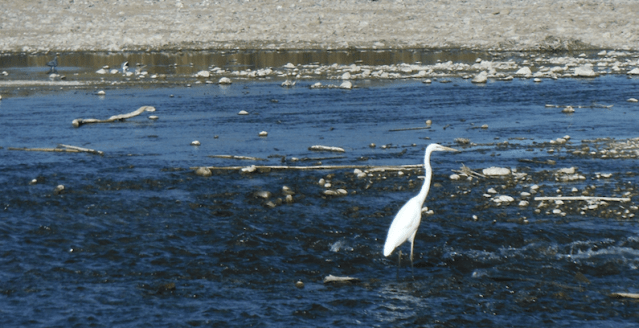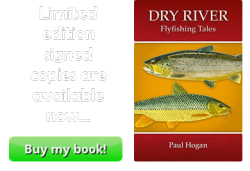It looks like a great white egret (Ardea alba) has made a home for itself in my local stretch of the Río Grande. This is a really strikingly beautiful bird and a bit of a rarity around these parts. My “Birds of Iberia” just lumps it with the miscellaneous “other birds” that are thrown in a loose pile between the main text and the index. It has nothing at all to say about it beyond describing it dismissively as an “accidental.” If my encounter with it was similarly described as accidental I would have to say it was a very happy accident!
The great white egret is a odd-looking bird. It is as skinny as hell (it looks like a bird trying to mimic a giraffe) and it is as white as snow. Despite their impressive stature they are very lightweight and I was surprised to find that their average weight is about a kilo which is similar to the weight of an average gypsy barbel of the same river. Like other herons, they are stealthy hunters and spear their prey with a dagger-like beak. Like other herons too, they often stand very still for a long time to allow their dinner to get within striking distance.
On the exposed shallows of the river a bird like this can be spotted from a mile. It towers above the little egret which is the only other bird it is likely to be confused with (I was fortunate to have had both birds obligingly stand close to one another to make the comparison possible).
I was pretty excited when I first saw it about ten days ago and it was obliging enough to allow me to drive reasonably close and get a good view. I got on to Harry Abbott later that evening to confirm the identity. Harry is a fishing buddy of mine and used to lead bird watching trips a few years back when he lived in Andalucía, and so I knew he would be a good one to ask. I probably caught Harry at a bad time because he was in the boozer with his chums after galloping around for a few hours on a horse. No doubt after all that fresh air and a few celebratory drinks he might have been feeling a bit light-headed but, being the pro that he is, he left his drink on the table long enough to fire off a few questions to help establish the identity of the mysterious bird.
Funnily enough a gentleman who I only know of through his initials, and who recently got in touch via the blog, also reported seeing a pair of great white egrets, among the usual avian suspects, on the Río Grande. This was within a few days of my own encounter. I hope that we might have a chance to visit the river together soon to see what other interesting things we can spot.
I returned to the river on Saturday to see if the bird was still there and to see if I could maybe manage a photograph. He (or she, for they cannot be distinguished outside of the breeding season) was indeed standing on a shingle bank close to the motorway bridge where we had our previous rendezvous. Like the little egret beside him, he decided to take to the air and both birds flew a little way upstream. It´s not easy to disappear when you are over three feet tall and you look as though you have been whitewashed, and so I was able to drive upstream within a couple of minutes to take another look at him.
Even though this species is rarely encountered here in Spain it is globally quite common and four very similar looking sub-species exist in Asia, Africa, the Americas and Southern Europe. The southern European stronghold seems to be further east in Italy and Greece and beyond.
Interestingly, the American population suffered a decline when there was a demand for their feathers for hats and in 1953 the great white egret in flight became the symbol of the National Audubon Society that was set up to help protect birds from various threats, including killing birds for their feathers!

This was as good a photograph as I could manage.

This lovely photograph of a great white egret shows the distinctive way the herons and bitterns fold their necks during flight. Like all egrets it is a member of the heron family. This photo was pilfered from the internet and I cannot give credit because I forget where I found it!


Hi Paul,
I was pleased that you had also seen one of the great white egrets. I did return to the bridge on the Rio Grande a few days later but only one bird was present there. You are correct of course in stating that males and females can only be distinguished in the breeding season but as the two birds I saw on my first visit seemed to be hunting together without any apparent territorial aggression I assumed they might well have been a pair. If so it would be nice to think that we might well see a few more of them around in the next few years! I will indeed be getting in touch soon regarding another visit to the Rio Grande.
Regards
Hi Paul,
I was wondering if the great white egrets were still around. I don`t know if you received my email but I will be back in Spain next week and will again visit the Rio Grande. I understand that there are also night herons and other heron species on your river during the breeding season and wondered when they return from their winter quarters. A night heron did turn up on the River Tywi in West Wales some years ago – a real rarity here. Little egrets on the other hand are now common here and they seem to cope better than I do with the cold, wet Welsh winters !
Looking forward to some warm Spanish sunshine
Regards
Flybri
Maestro, good to hear from you. I didn´t get your email I´m afraid. It might have gone into my junk mail and got dumped by mistake. Perhaps you might be good enough to send it again? (paulmhogan@hotmail.com) Let me know when you are around and we could wander down to the river and see what birds are around. As for the GWE I haven´t been to the river for a couple of weeks (I get distracted by the six nations!) and so I don´t know if it´s still around. Maybe I might take a peak tomorrow! All the best, P
Yesterday I returned to Wales from our week in Andalucía. While there I again visited the Rio Grande. I was pleased to find that the two great white egrets were still in residence as were several other very interesting birds. The highlight for me, however, was the thrill of observing at very close quarters the behaviour of gypsy barbel in the low and clear waters of the river`s pools while Paul, unfortunately for me, was hard at work !
On my return I was pleased to discover that Paul`s book “Dry River” had arrived from Coch y Bonddu Books. Being late on, and having spent a tiring day travelling, it should really have been put aside for the morrow but on seeing the fabulous illustrations on the dust cover of fish painted by Paul I was tempted of course to look inside. I was hooked first cast on reading his “Introduction” and several hours later I had read several chapters and many of the “pears of wisdom” that he had insisted would not be found there. It had taken me some time as I had been enthralled by his writing and it definitely was not to be rushed.
In the first chapter entitled “Dry River” he describes the challenges of surviving faced by the barbel and of his feelings towards these fish and their river. He writes of a day when he watched his son Leo standing motionless in the river, unable to cast, as he had …. “fallen under the spell of the barbel swimming around him” – and he wondered if those fish …. “might in time become ghosts that haunt him too”. Although it had been my first opportunity to closely observe these wonderful fish I knew that I also had come under their spell as Paul had described.
Reading his writings in this and later chapters, and enjoying more superb illustrations, confirmed for me this author`s great talents. This is a book full of humour but also of deeper thoughts and emotions about the environment and about life itself.
In the chapter “Mentors” the term “bullshitter” is described wonderfully as a person held in high esteem who delights in words and has uncommon skill in their manipulation and in their use …. in comedy and as a means of exploring new and untrammelled thoughts. Paul`s grasp of language is impressive indeed, but for me, in a very positive and complementary sense, it is very much a term that describes the author. I fully understand why his English teaching colleague and others encouraged him to write and publish and why his wife took the decision to set up this blog. His brother and mum must j[have enjoyed every word and his father would have been proud.
A fabulous read that`s not to be missed!
So I look forward to finishing the book soon and to tales of fishing, people and places in Ireland and New Zealand. Without doubt I will be reading it again many times in the future and probably on the plane when heading back to the Rio Grande.
Thankyou Mr Hogan
Enjoy the six nations !
I don´t know what to say! Thank you so much for your wonderful endorsement. It is deeply appreciated.
I would just like to apologise for introducing the word “pears”. What I meant of course was “pearls” of wisdom. Sorry Paul !